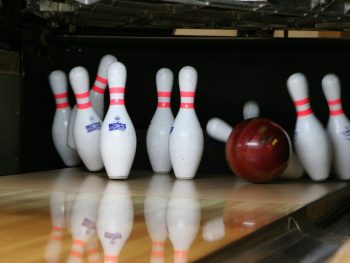Most modern bowling lanes are prepared for electronic scoring, but it is important to understand how to score bowling when electronic scoring is not available. There are 2 parts to scoring a bowling game. First, you should know the point values and rules associated with the different types of pin throwing patterns. Second, you must know how to indicate these different point values on the scorecard. With this information in hand, you can have fun with your friends at the bowling alley.
Score the tenth board differently if you get a strike or a spare. If, during your last frame, you have an open frame, rate the frame as you normally would. However, if you get a spare or a strike, you’ll get a third throw during the framing. This additional spread, called a filler ball, will allow you to mark the hit or spare. Simply treat this third ball the same way you would treat the first throw after a spare or the second throw after a hit.
Add up the total number of pins knocked down on your 2 shots when your turn is over. For example, if your current score is 30 and the numbers at the top of the scorecard chart you just completed are 5 and 4, you would add 9 (5 plus 4) to 30. Your current score would then be 39.
Mark the scorecard with a dash if you lose the pins. If the ball goes into the gutter or if you miss the pins, indicate with a horizontal dash (-). For example, if your ball went into the gutter on your first roll, you would mark a dash in the small box at the top center of the scoreboard. If the ball went into the gutter on the second throw, you would mark a dash in the small box at the top right of the scorecard box.
Place a forward slash on the small square in the upper-right corner of the scorecard to indicate that there is a spare. A forward slash (a line connecting the lower-left corner to the upper right corner of the box in the upper right corner) indicates that you did not knock down all the pins on your first roll, but did so on your second roll.
Mark a strike by adding 10 to the sum of the following 2 shots. For example, if you throw a shot, then in your next 2 shots you knock down a total of 7 pins, your shot will be worth 17 points (10 plus 7).
Use the scoreboard that corresponds to the turn you are taking. Above each scorecard column is a number. These numbers go from left to right, starting with “1” and going up to “10”. Count each player’s score within the frame of the scorecard that matches the turn they are taking. For example, in your first turn, use the chart from the first scorecard. In your fifth turn, use the frame from the fifth scorecard, and so on.
Write the total number of pins that have been knocked down on the small boxes on each scorecard. Record the total number of dowel pins on their first roll in the small box in the top-center position. Write the second total of the run into the box at the top right of each scorecard.
Mark a foul with an “F”. If you pass the foul line (the line beyond which a bowler cannot pass) in your first turn, place an “F” in the small box just to the left of the one at the top right of the scoreboard. If you pass the foul line on your second turn, place an “F” inside the small box at the top right of the scoreboard.
Count the totals of your pins from left to right in the tenth box. When you reach the final board, you will see 3 small squares along the top of the scorecard instead of just the two standard squares. Mark your score in this final scoreboard by moving from left to right.
Write an “X” in the small box at the top right of the scoreboard to indicate a strike. A hit indicates that you knock down all 10 pins in your first throw. While the small box at the top right of the scoreboard is typically reserved for scoring information that relates to the second roll of your turn, the scoring rules make an exception for strike.
Get a spare by adding 10 to the number of pins knocked down on the next die roll. For example, if you knock down 5 pins on the roll following your replacement, the table is worth 15 points (10 plus 5).
Understand the parts of the bowling scorecard. At the left end of the bowling scorecard, there is a list of empty spaces where you can write the names of each player in the bowling game. To the right of the row where you write the names of the players, there are 10 squares of scorecards. Each box is used to add up the score for a single spin.
Determine the winner by comparing the final score of the tenth frame. For example, if your score on the tenth frame is 110 and your friend’s is 100, you have won the game. Congratulations!
Next Steps and Where to Purchase Equipment
When you’re ready to make the leap, you can read these articles to learn what bowling equipment we recommend for every different kind of player and choose what suits you better. We try to review the best bowling equipment in the market every few weeks to keep up-to-date with the current trends.













 How To Become Great At Bowling
How To Become Great At Bowling